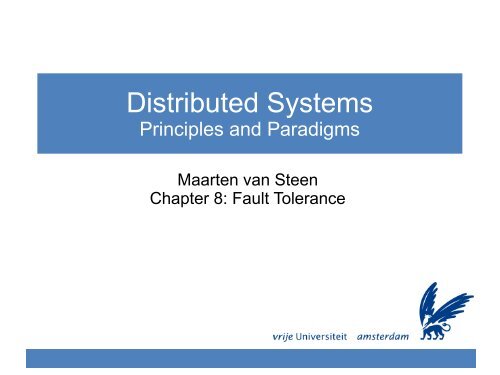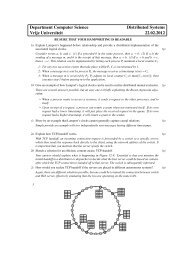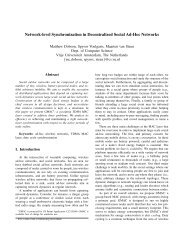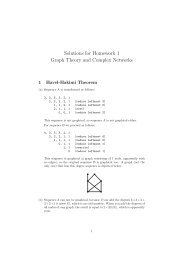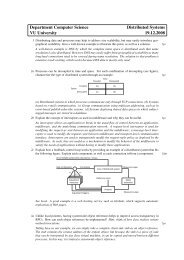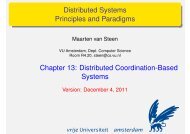R - Maarten van Steen
R - Maarten van Steen
R - Maarten van Steen
Create successful ePaper yourself
Turn your PDF publications into a flip-book with our unique Google optimized e-Paper software.
Distributed Systems<br />
Principles and Paradigms<br />
<strong>Maarten</strong> <strong>van</strong> <strong>Steen</strong><br />
Chapter 8: Fault Tolerance
Dependability<br />
• A component provides services to clients. To provide<br />
services, the component may require the services from<br />
other components → a component may depend on some<br />
other component.<br />
• A component C depends on C* if the correctness of C's<br />
behavior depends on the correctness of C*'s behavior.<br />
• Note: in the context of distributed systems, components<br />
are generally processes or channels.<br />
Availability<br />
Reliability<br />
Safety<br />
Maintainability<br />
Readiness for usage<br />
Continuity of service delivery<br />
Very low probability of catastrophes<br />
How easily can a failed system be repaired<br />
8.1 Introduction: Basic concepts
Reliability versus Availability<br />
• Reliability R(t): probability that a component has been up<br />
and running continuously in the time interval [0,t).<br />
• Some traditional metrics:<br />
– Mean Time To Failure (MTTF): Average time until a component<br />
fails.<br />
– Mean Time To Repair (MTTR): Average time it takes to repair a<br />
failed component.<br />
– Mean Time Between Failures (MTBF): MTTF + MTTR<br />
8.1 Introduction: Basic concepts
Reliability versus Availability<br />
• Availability A(t): Average fraction of time that a<br />
component has been up and running in the interval [0,t)<br />
– (Long term) availability A: A(∞)<br />
• Note:<br />
– A = MTTF/MTBF = MTTF/(MTTF + MTTR)<br />
Observation<br />
Reliability and availability make sense only if we have an<br />
accurate notion of what a failure actually is<br />
8.1 Introduction: Basic concepts
Terminology<br />
Term Description Example<br />
Failure<br />
May occur when a<br />
component is not living up to<br />
its specifications<br />
A crashed program<br />
Error<br />
Part of a component that<br />
may lead to a failure<br />
A programming bug<br />
Fault The cause of an error A sloppy programmer<br />
8.1 Introduction: Basic concepts
Terminology<br />
Term Description Example<br />
Fault<br />
prevention<br />
Prevent the occurrence<br />
of a fault<br />
Don't hire sloppy<br />
programmers<br />
Fault<br />
tolerance<br />
Fault removal<br />
Fault<br />
forecasting<br />
Build a component such<br />
that it can mask the<br />
occurrence of a fault<br />
Reduce the presence,<br />
number, or seriousness<br />
of a fault<br />
Estimate current<br />
presence, future<br />
incidence, and<br />
consequences of faults<br />
Build each component by<br />
two independent<br />
programmers<br />
Get rid of sloppy<br />
programmers<br />
Estimate how a recruiter is<br />
doing when it comes to<br />
hiring sloppy programmers
Failure models<br />
<br />
<br />
Crash failures: Halt, but correct behavior until halting<br />
General omission failures: failure in sending or receiving messages<br />
−<br />
Receiving omissions: sent messages are not received<br />
<br />
<br />
−<br />
Send omissions: messages are not sent that should have<br />
Timing failures: correct output, but provided outside a specified time<br />
interval.<br />
−<br />
Performance failures: the component is too slow<br />
Response failures: incorrect output, but cannot be accounted to another<br />
component<br />
−<br />
Value failures: wrong output values<br />
<br />
−<br />
State transition failures: deviation from correct flow of control (Note: this failure<br />
may initially not even be observable)<br />
Arbitrary failures: any (combination of) failure may occur, perhaps even<br />
unnoticed<br />
8.1 Introduction: Failure models
Dependability versus security<br />
<br />
<br />
Omission failure: A component fails to take an action<br />
that it should have taken<br />
Commission failure: A component takes an action that it<br />
should not have taken<br />
Observations<br />
Deliberate failures, be they omission or commission<br />
failures, stretch out to the field of security<br />
There may actually be a thin line between<br />
dependability and security<br />
8.1 Introduction: Failure models
Halting failures<br />
• Scenario: C no longer perceives any activity from C* ― a<br />
halting failure? Distinguishing between a crash or<br />
omission/timing failure may be impossible:<br />
– Asynchronous system: no assumptions about process execution<br />
speeds or message delivery times → cannot reliably detect<br />
crash failures.<br />
– Synchronous system: process execution speeds and message<br />
delivery times are bounded → we can reliably detect omission<br />
and timing failures.<br />
– In practice we have partially synchronous systems: most of the<br />
time, we can assume the system to be synchronous, yet there is<br />
no bound on the time that a system is asynchronous → can<br />
normally reliably detect crash failures.<br />
8.1 Introduction: Failure models
Halting failures<br />
• Assumptions we can make:<br />
– Fail-stop: Crash failures, but reliably detectable<br />
– Fail-noisy: Crash failures, eventually reliably detectable<br />
– Fail-silent: Omission or crash failures: clients cannot tell what<br />
went wrong.<br />
– Fail-safe: Arbitrary, yet benign failures (can't do any harm).<br />
– Fail-arbitrary: Arbitrary, with malicious failures<br />
8.1 Introduction: Failure models
Process reslience<br />
<br />
Basic idea: protect yourself against faulty processes<br />
through process replication:<br />
8.2 Process resilience
Groups and failure masking<br />
<br />
<br />
k-Fault-tolerant group: When a group can mask any k<br />
concurrent member failures (k is called degree of fault<br />
tolerance).<br />
How large must a k-fault-tolerant group be:<br />
−<br />
−<br />
With halting failures (crash/omission/timing failures): we<br />
need k+1 members: no member will produce an<br />
incorrect result, so the result of one member is good<br />
enough.<br />
With arbitrary failures: we need 2k+1 members: the<br />
correct result can be obtained only through a majority<br />
vote.<br />
8.2 Process resilience
Groups and failure masking<br />
<br />
<br />
Important:<br />
−<br />
−<br />
All members are identical<br />
All members process commands in the same order<br />
Result:<br />
−<br />
Only then do we know that all processes are programmed to do<br />
exactly the same thing.<br />
Observation<br />
The processes need to have consensus on which<br />
command to execute next<br />
8.2 Process resilience
Flooding-based consensus<br />
• Assume:<br />
– Fail-crash semantics<br />
– Reliable failure detection<br />
– Unreliable communication<br />
• Basic idea:<br />
– Processes multicast their proposed operations<br />
– All apply the same selection procedure → all process will execute the<br />
same if no failures occur<br />
• Problem:<br />
– Suppose a process crashes before completing its multicast<br />
8.2 Process resilience
Flooding-based consensus
Paxos<br />
• Assumptions (rather weak ones):<br />
– An asynchronous system<br />
– Communication may be unreliable (meaning that messages may<br />
be lost, duplicated, or reordered)<br />
– Corrupted messages are detectable (and can thus be discarded)<br />
– All operations are deterministic<br />
– Process may exhibit halting failures, but not arbitrary failures,<br />
nor do they collude.<br />
8.2 Process resilience: Paxos
Essential Paxos<br />
• A collection of (replicated) threads, collectively fulfilling<br />
the following roles:<br />
– Client: a thread that requests to have an operation performed<br />
– Learner: a thread that eventually performs an operation<br />
– Acceptor: a thread that operates in a quorum to vote for the<br />
execution of an operation<br />
– Proposer: a thread that takes a client's request and attempts to<br />
have the requested operation accepted for execution<br />
8.2 Process resilience: Paxos
Essential Paxos<br />
• Safety (nothing bad will happen):<br />
– Only proposed operations will be learned<br />
– At most one operation will be learned (and subsequently executed before<br />
a next operation is learned)<br />
• Liveness (something good will eventually happen):<br />
– If sufficient processes remain nonfaulty, then a proposed operation will<br />
eventually be learned (and thus executed)<br />
8.2 Process resilience: Paxos
Essential Paxos
Paxos: Phase 1a (prepare)<br />
• A proposer P:<br />
– has a unique ID, say i<br />
– communicates only with a quorum of acceptors<br />
– For requested operation cmd:<br />
– Selects a counter n higher than any of its previous counters, leading to a proposal<br />
number r = (m,i).<br />
Note: (m,i) < (n,j) iff m < n or m = n and i < j<br />
– Sends prepare(r) to a majority of acceptors<br />
• Goal:<br />
– Proposer tries to get its proposal number anchored: any previous proposal<br />
failed, or also proposed cmd.<br />
Note: previous is defined wrt proposal number<br />
8.2 Process resilience: Paxos
Paxos: Phase 1b (promise)<br />
• What the acceptor does:<br />
– If r is highest from any proposer:<br />
– Return promise(r) to p, telling the proposer that the acceptor will ignore<br />
any future proposals with a lower proposal number.<br />
– If r is highest, but a previous proposal (r',cmd') had already been<br />
accepted:<br />
– Additionally return (r',cmd') to p. This will allow the proposer to decide<br />
on the final operation that needs to be accepted.<br />
– Otherwise: do nothing – there is a proposal with a higher<br />
proposal number in the works<br />
8.2 Process resilience: Paxos
Paxos: Phase 2a (accept)<br />
• It's the proposer's turn again:<br />
– If it does not receive any accepted operation, it sends<br />
accept(r,cmd) to a majority of acceptors<br />
– If it receives one or more accepted operations, it sends<br />
accept(r,cmd*), where<br />
– r is the proposer's selected proposal number<br />
– cmd* is the operation whose proposal number is highest among all<br />
accepted operations received from acceptors.<br />
8.2 Process resilience: Paxos
Paxos: Phase 2b (learn)<br />
• An acceptor receives an accept(r,cmd) message:<br />
– If it did not send a promise(r') with r' > r, it must accept cmd, and<br />
says so to the learners: learn(cmd).<br />
• A learner receiving learn(cmd) from a majority of<br />
acceptors, will execute the operation cmd.<br />
Observation<br />
The essence of Paxos is that the proposers drive a majority<br />
of the acceptors to the accepted operation with the highest<br />
anchored proposal number<br />
8.2 Process resilience: Paxos
Essential Paxos: Hein Meling<br />
Associate professor @ University Sta<strong>van</strong>ger
Essential Paxos: Normal case
Essential Paxos: Normal case
Essential Paxos: Normal case
Essential Paxos: Normal case
Essential Paxos: Normal case
Essential Paxos: Normal case
Essential Paxos: Normal case
Essential Paxos: Problematic case
Essential Paxos: Problematic case
Essential Paxos: Problematic case
Essential Paxos: Problematic case
Essential Paxos: Problematic case
Essential Paxos: Problematic case
Essential Paxos: Problematic case
Essential Paxos: Problematic case
Essential Paxos: Problematic case
Essential Paxos: Problematic case
Essential Paxos: Problematic case
Essential Paxos: Problematic case
Essential Paxos: Problematic case
Essential Paxos: Problematic case
Essential Paxos: Problematic case
Essential Paxos: Problematic case
Essential Paxos: Problematic case
Failure detection<br />
• General model:<br />
– Each process is equipped with a failure detection module<br />
– A process p probes another process q for a reaction<br />
– q reacts → q is alive<br />
– q does not react within t time units → q is suspected to have crashed<br />
• Note: in a synchronous system:<br />
Issue<br />
How can we reliably detect that a process has<br />
actually crashed?<br />
– a suspected crash is a known crash<br />
– Referred to as a perfect failure detector<br />
8.2 Process resilience: detection
Failure detection<br />
• Practice: the eventually perfect failure detector<br />
• Has two important properties:<br />
– Strong completeness: every crashed process is eventually suspected to have<br />
crashed by every correct process.<br />
– Eventual strong accuracy: eventually, no correct process is suspected by any<br />
other correct process to have crashed.<br />
• Implementation:<br />
– If p did not receive heartbeat from q within time t → p suspects q.<br />
– If q later sends a message (received by p):<br />
– p stops suspecting q<br />
– p increases timeout value t<br />
– Note: if q does crash, p will keep suspecting q.<br />
8.2 Process resilience: detection


